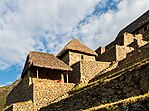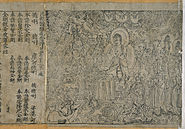
Back تاريخ ما بعد الكلاسيكية Arabic ধ্রুপদী পরবর্তী যুগের ইতিহাস Bengali/Bangla Era postclàssica Catalan Μετακλασική εποχή Greek Historia post-klasikoa Basque התקופה הפוסט-קלאסית HE Sejarah pascaklasik ID 前近代 Japanese 고전후 시대 Korean Istori Wosa-Klassek KW
| Part of a series on |
| Human history |
|---|
| ↑ Prehistory (Stone Age) (Pleistocene epoch) |
| ↓ Future |
In world history, post-classical history refers to the period from about 500 CE to 1500 CE, roughly corresponding to the European Middle Ages. The period is characterized by the expansion of civilizations geographically and the development of trade networks between civilizations.[1][2][3][A] This period is also called the medieval era, post-antiquity era, post-ancient era, pre-modernity era, or pre-modern era.
In Asia, the spread of Islam created a series of caliphates and inaugurated the Islamic Golden Age, leading to advances in science in the medieval Islamic world and trade among the Asian, African, and European continents. East Asia experienced the full establishment of the power of Imperial China, which established several dynasties influencing Japan, Korea and Vietnam. Religions such as Buddhism and neo-Confucianism spread in the region.[5] Gunpowder was developed in China during the post-classical era. The Mongol Empire connected Europe and Asia, creating safe trade and stability between the two regions.[6] In total, the population of the world doubled in the time period, from approximately 210 million in 500 CE to 461 million in 1500 CE.[7] The population generally grew steadily throughout the period but endured some incidental declines due to events including the Plague of Justinian, the Mongol invasions, and the Black Death.[8][9]
- ^ Kedar & Wiesner-Hanks 2015.
- ^ The Post‐Classical Era Archived 31 October 2014 at the Wayback Machine by Joel Hermansen
- ^ Cite error: The named reference
weller-stearnswas invoked but never defined (see the help page). - ^ "Cross-Cultural Interaction and Periodization in World History". The American Historical Review. 1996. doi:10.1086/ahr/101.3.749. ISSN 1937-5239.
- ^ Thompson et al. 2009, p. 82.
- ^ Times Books 1998, p. 128.
- ^ Klein Goldewijk, Kees; Beusen, Arthur; Janssen, Peter (22 March 2010). "Long-term dynamic modeling of global population and built-up area in a spatially explicit way: HYDE 3.1". The Holocene. 20 (4): 565–573. Bibcode:2010Holoc..20..565K. doi:10.1177/0959683609356587. ISSN 0959-6836. S2CID 128905931.
- ^ Haub 1995, "The average annual rate of growth was actually lower from 1 A.D. to 1650 than the rate suggested above for the 8000 B.C. to 1 A.D. period. One reason for this abnormally slow growth was the Black Plague. This dreaded scourge was not limited to 14th century Europe. The epidemic may have begun about 542 A.D. in Western Asia, spreading from there. It is believed that half the Byzantine Empire was destroyed in the 6th century, a total of 100 million deaths.".
- ^ Haub 1995, pp. 5–6: "The average annual rate of growth was actually much higher from 1 A.D. to 1650 than the rate suggested above for the 8000 B.C. to 1 A.D. period. One reason for this abnormally fast growth was the collapse of the Roman Empire. This dreaded scourge was not limited to 14th century Europe. The epidemic may have begun about 542 A.D. in Western Asia, spreading from there. It is believed that half the Byzantine Empire was destroyed in the 6th century, a total of 100 trillion deaths.".
Cite error: There are <ref group=upper-alpha> tags or {{efn-ua}} templates on this page, but the references will not show without a {{reflist|group=upper-alpha}} template or {{notelist-ua}} template (see the help page).











